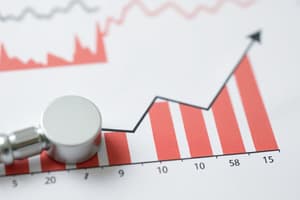Podcast
Questions and Answers
What does the term 'econometrics' refer to?
What does the term 'econometrics' refer to?
Econometrics refers to 'economic measurement' and involves applying mathematical statistics to economic data.
Why is econometrics considered a distinct discipline?
Why is econometrics considered a distinct discipline?
Econometrics is distinct because it combines economic theory, mathematical economics, and economic statistics to provide numerical measures to theoretical hypotheses.
What is the main task of econometricians?
What is the main task of econometricians?
The main task of econometricians is to provide numerical estimates and empirical verification of economic relationships implied by theories.
How does economic theory typically present its hypotheses?
How does economic theory typically present its hypotheses?
What is the role of statistical inference in econometrics?
What is the role of statistical inference in econometrics?
What is the primary focus of mathematical economics as opposed to econometrics?
What is the primary focus of mathematical economics as opposed to econometrics?
What distinguishes economic statistics from econometrics?
What distinguishes economic statistics from econometrics?
Give an example of a hypothesis in microeconomic theory related to price and quantity demanded.
Give an example of a hypothesis in microeconomic theory related to price and quantity demanded.
Flashcards
Econometrics definition
Econometrics definition
The application of mathematical statistics to economic data to support economic models and find numerical results.
Econometrics vs. Economic Theory
Econometrics vs. Economic Theory
Economic theory is qualitative, stating relationships; econometrics provides the numerical measures of those relationships.
Econometrics vs. Mathematical Economics
Econometrics vs. Mathematical Economics
Mathematical economics focuses on expressing economic theory in equations; econometrics tests the empirical validity of those same theories.
Econometrics vs. Economic Statistics
Econometrics vs. Economic Statistics
Signup and view all the flashcards
Econometrics as a separate discipline
Econometrics as a separate discipline
Signup and view all the flashcards
Econometric Research Methodology
Econometric Research Methodology
Signup and view all the flashcards
Qualitative vs. Quantitative
Qualitative vs. Quantitative
Signup and view all the flashcards
Price sensitivity
Price sensitivity
Signup and view all the flashcards
Study Notes
Introduction to Applied Econometrics
- Econometrics is the quantitative analysis of real-world economic phenomena, using theory and statistical techniques.
- It merges economic theory, mathematical economics, economic statistics, and mathematical statistics.
- Econometric research combines economic theory with actual measurements, using statistical inference.
- Economic theory offers qualitative statements, but not numerical measures of relationships.
- Econometrics provides the numerical estimates of these relationships.
What is Econometrics?
- Econometrics can be understood as "economic measurement."
- It involves applying mathematical statistics to economic data to support mathematical economic models and derive numerical results.
- It employs a quantitative analysis of economic phenomena, guided by both theory and observation, using appropriate inference methods.
- It aims to empirically determine economic laws.
Why is Econometrics a Separate Discipline?
- Combining economic theory and mathematical models requires a distinct approach since theory often lacks numerical measurement of relationships.
- Economic theory provides qualitative statements or hypotheses.
Econometric Model of Consumption
- Microeconomic theory suggests price reductions increase commodity demand.
- This involves a negative relationship between price and quantity demanded, but it doesn't quantify the extent of the change.
- Econometricians aim to provide these numerical estimates.
Mathematical Economics
- Mathematical economics expresses economic theory in mathematical forms (equations) without considering measurability or empirical verification.
- Econometrics focuses on empirical verification of economic theory.
Economic Statistics
- Economic statistics collects, processes, and presents economic data as charts and tables.
- The economic statistician provides the baseline data; the econometrician builds on, and further-examines, these data.
Methodology of Econometrics
- Econometric methodology typically involves these steps:
- Statement of theory or hypothesis.
- Specifying the mathematical and statistical models for the theory.
- Obtaining economic data
- Estimating parameters for the model
- Testing hypotheses derived from the estimations
- Forecasting or predicting using the model
- Using the model for control or policy purposes
Keynesian Consumption Function: Statement of Theory or Hypothesis
- Keynes posited a marginal propensity to consume (MPC) between 0 and 1 (0<MPC<1)
- This means that an increase in income will increase consumption.
Keynesian Consumption Function: Specification of the Mathematical Model
- Consumption (Y) is related to income (X) by a linear equation: Y = β1 + β2X, where:
- β1 is the intercept.
- β2 is the slope coefficient (MPC).
Keynesian Consumption Function: Specification of the Econometric Model
- The exact mathematical relationship between consumption and income is not always true; it's influenced by other factors.
- This is addressed by using a deterministic consumption function Y = β1 + β2 X +u (error term)
Keynesian Consumption Function: Obtaining Data
- Obtaining consumption and income data is necessary to estimate the econometric model's parameters.
- Real-world data (such as that in a table) is used to calculate the estimated consumption function parameters.
Keynesian Consumption Function: Estimation of the Model
- Statistical techniques like regression analysis provide numerical estimates of the parameters (β1 and β2) of the consumption function.
- An estimated consumption function is provided: Y^ = -184.08 + 0.7064X
Keynesian Consumption Function: Hypothesis Testing
- Testing whether the estimations align with the predictions of the theory (expected MPC to be positive and less than 1).
- Calculating whether the model's predictions correlate accurately with real data.
Keynesian Consumption Function: Forecasting or Prediction
- Used to predict mean consumption expenditure for a specific year, using GDP figures.
- The actual value of consumption in 1997 is compared to the forecast.
Keynesian Consumption Function: Use of Model for Policy Purposes
- Using the estimated consumption function to determine income levels necessary for target consumer spending given the current unemployment rate.
- Using the model to evaluate how policy can manipulate factors to produce economic goals.
Summary of Econometric Modeling Anatomy
- A chart showing the sequence of steps from economic theory to testing and policy use.
Studying That Suits You
Use AI to generate personalized quizzes and flashcards to suit your learning preferences.




